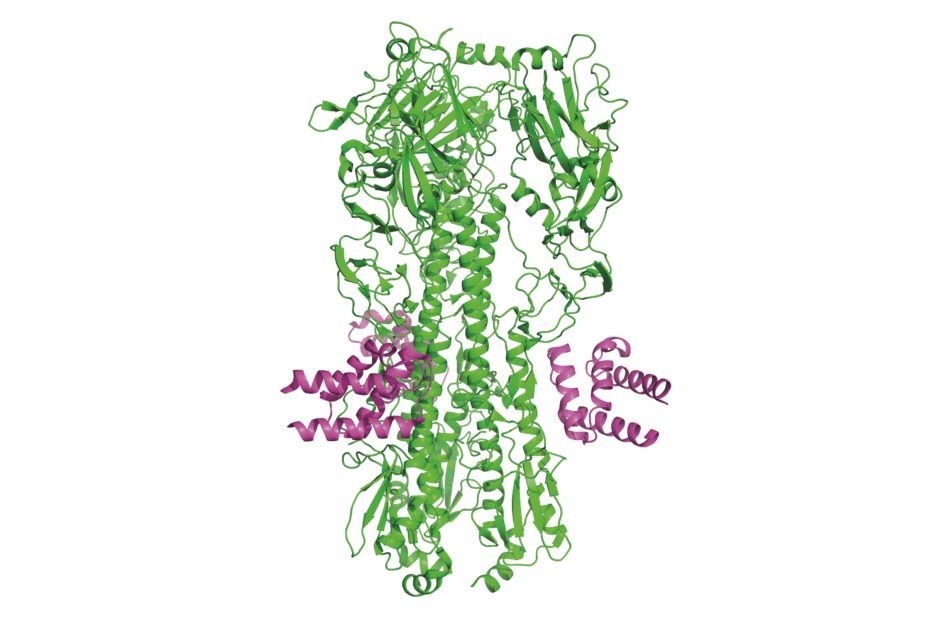
Koday et al / University of Washington
Ongoing mutations of influenza virus surface proteins mean a different flu vaccine must be used each year, but researchers think they may have found a novel antiviral drug that could protect against a variety of influenza strains.
The researchers, who published their findings in PLOS Pathogens
[1]
(online, 4 February 2016), found that one dose of peptide antiviral HV36.6, given two hours before exposure to a lethal dose of three different strains of virulent influenza (two H1N1 and one H5N1 strain), stopped the mice from dying. All mice in the group treated with HV36.6 survived, compared with none in the control group given lysozyme protein.
Wendy Barclay, chair of influenza virology at Imperial College London’s department of medicine who was not involved in the research, describes the peptide as “a real step forward” in the hunt to find a broadly protective flu treatment. “It will be exciting to see whether it can be taken to the next stage [of development],” she says.
However, when the peptide was administered to the mice after exposure to the virus it was not as effective. Given one day after exposure, 60% of mice survived after 14 days, while all mice given the peptide two or more days after exposure died.
The peptide was still superior to the antiviral medication oseltamivir, the researchers say, which was administered to mice twice a day for five days starting one day after exposure. However, when the two medications were combined and given one day after exposure, survival jumped back to 100%.
The peptide was designed using a computer programme so that it would bind to a specific part of the viral hemagglutinin stem region — a portion of the influenza virus that is very similar even among diverse strains. The peptide binds to the same region as broadly neutralising antibodies which have been found to protect against multiple flu strains, a discovery that was deemed a significant breakthrough in flu research.
“In recent years there has been excitement about the discovery that there is an ‘Achilles heel’ in the influenza hemagglutinin protein… that might offer a target for vaccines or antivirals that would be cross reactive with all the different influenza viruses that exist or might evolve,” explains Barclay. However, it has proved difficult to develop a vaccine that induces production of these antibodies.
Barclay adds that the advantage of the H36.6 peptide is that “it does not need to be induced by vaccination and it works against the [flu] virus even in the absence of an immune system”.
New treatment strategies for seasonal and pandemic flu is an area of ongoing research. Current seasonal flu vaccines are strain-specific and can become less effective if viruses genetically ‘drift’; they also depend on imperfect predictions of what strains will be in circulation. Treatment with antiviral neuraminidase inhibitors is only able to lessen disease severity to a limited degree.
The H36.6 peptide is therefore promising, says Barclay, but it is not as “cross-reactive” as might be desired. “It does not work well against one of the two groups of natural influenza viruses, that includes the H3 viruses that currently cause a proportion of seasonal influenza,” she explains. “[But] the authors themselves point out that we do not yet know how likely it is that the influenza virus can evolve to escape therapies that target this region of hemagglutinin.”
Barclay adds that as the antiviral is a peptide, it could trigger the immune system to develop antibodies against it, making a second use ineffective. But she points out that the authors did examine this possibility and did not find it to be the case in mice. She also cautions that the researchers did find that cytokine levels were high after administration which could cause side effects in humans.
References
[1] Koday MT, Nelson J, Chevalier A et al. A computationally designed hemagglutinin stem-binding protein provides in vivo protection from influenza independent of a host immune response. PLOS Pathogens 2016;12(2):e1005409. doi: 10.1371/journal.ppat.1005409


